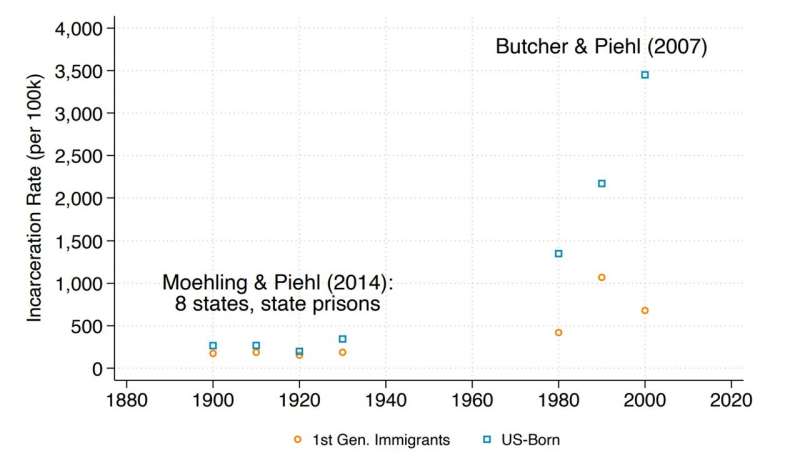This article has been reviewed according to Science X's editorial process and policies. Editors have highlighted the following attributes while ensuring the content's credibility:
fact-checked
trusted source
proofread
Immigrants found to be significantly less likely to commit crimes than the US-born

Some Americans believe that undocumented immigrants are a criminal threat to society. Former President Donald J. Trump has leveraged this assumption to inflame the rhetoric around immigration from the U.S.-Mexico border.
A study co-led by Northwestern University economist Elisa Jácome provides the first historical comparison of incarceration rates of immigrants to U.S.-born citizens.
Using incarceration rates as a proxy for crime, a team of economists analyzed 150 years of U.S. Census data and found immigrants were consistently less likely to be incarcerated than people born in the U.S.
They also found beginning in 1960, the incarceration gap widened such that immigrants today are 60% less likely to be incarcerated than the U.S.-born.
"Our study shows that since 1870, it has never been the case that immigrants as a group have been more incarcerated than the U.S.-born," Jácome said.
Jácome is an assistant professor of economics and a faculty fellow with the Institute for Policy Research at Northwestern.
The study co-authors are Ran Abramitzky, professor of economics at Stanford University; Leah Boustan, professor of economics at Princeton University; Santiago Pérez, associate professor of economics at the University of California at Davis; and Juan David Torres, doctoral student in economics at Stanford.
"Law-Abiding Immigrants: The Incarceration Gap Between Immigrants and the U.S.-born, 1850–2020" was released as a working paper by the National Bureau of Economic Research and will be published in the American Economic Review: Insights.
The multi-university team of economists had previously studied the upward mobility of immigrants and found that children of low-income immigrants tended to be more upwardly mobile than U.S.-born children of low-income families.
Prompted by frequent questions about the impact of immigration on local crime rates, the researchers used data from the U.S. Census to find out whether immigrants were more likely to commit crimes than the U.S.-born.
Starting with the 1870 U.S. Census—the first to include the full population, including those formerly enslaved—through the most recent in 2020, which collects data nationwide, including from correctional facilities, the researchers measured the gaps between immigrant and U.S.-born levels of incarceration.
Over that 150-year period, they found that immigrants' incarceration rate was only slightly lower than that of U.S.-born men. However, in the more recent time period, immigrants are 60% less likely to be incarcerated than U.S.-born citizens and 30% less likely relative to U.S.-born whites.
To explain what happened beginning in 1960, Jácome and co-authors point to globalization and skill-based technological changes as coinciding with the gap.
"A surprising finding was the extent to which immigrants with lower levels of education today are significantly less likely to commit crimes than their U.S.-born counterparts," Jácome said. "This may indicate immigrants are more resistant to economic shocks that have affected less-educated men in recent decades."
The researchers say policymakers should consider a variety of factors in addressing immigration issues.
"The impact of immigration on the economy is a multifaceted topic, and crime is just one of the factors," Jácome said. "To get a holistic picture, policymakers should also account for research, invention, and services that are being provided because of immigrants.
"To the extent you want to make a cost-benefit statement about immigration, you must also look at benefits lost if immigration was reduced."
More information: Ran Abramitzky et al, Law-Abiding Immigrants: The Incarceration Gap Between Immigrants and the US-born, 1850–2020, National Bureau of Economic Research (2023). DOI: 10.3386/w31440
Provided by Northwestern University


















